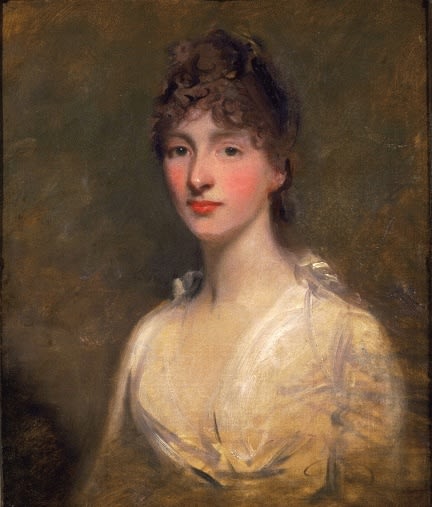
John Hoppner RA
Portrait of Mary Anne, Viscountess Lifford (1786-1877), c. 1790
Oil on canvas
24 x 20 in. (61 x 50.5 cm)
Philip Mould & Co.
To view all current artworks for sale visit philipmould.com Along with Gainsborough and Reynolds, Hoppner was one of the leading portrait painters in late eighteenth-century Britain. Born in London...
To view all current artworks for sale visit philipmould.com
Along with Gainsborough and Reynolds, Hoppner was one of the leading portrait painters in late eighteenth-century Britain. Born in London on 25 April 1758, he entered the Royal Academy Schools in 1775, where he won a Gold Medal in 1782. He was a regular contributor to the Royal Academy exhibitions and quickly established himself as a fashionable portrait painter. He was appointed painter to the Prince of Wales in 1789.
At first his work was inspired by the later portraits of Reynolds, but he soon developed an individual style that is distinguished by bravura and vivacity, combined with a strong feeling of character. From the 1790s he was also the only serious rival to the young Lawrence and with him was responsible for painting the finest Romantic portraits of the Regency period. These works (of which the present portrait is a fine example), show a deliberate move away from the classicism of Reynolds, towards a more emotional and natural-looking image.
The chief appeal of this work is its spontaneity, heightened by the fact that it is apparently an unfinished work, or a preparatory study for an as-yet unknown larger work. This painting enables us to see the freshness of Hoppner's technique, in which bold, impasto strokes suggest the fall of light and drapery, whilst in a characteristic passage (comparable, for example, to his Portrait of an Unknown Woman Christie’s Important British Pictures November 17th 1989) an apparent tangle of chocolate brown brushstrokes brilliantly creates the sitter's hair.
Mary Anne Maude, daughter of the 1st Lord Hawarden married James Hewitt April 15th 1809, who succeeded to the title of 3rd Viscount Lifford in 1830. She outlived her husband by some twenty-two years, dying in Torquay in 1877 at the age of ninety-two.
Along with Gainsborough and Reynolds, Hoppner was one of the leading portrait painters in late eighteenth-century Britain. Born in London on 25 April 1758, he entered the Royal Academy Schools in 1775, where he won a Gold Medal in 1782. He was a regular contributor to the Royal Academy exhibitions and quickly established himself as a fashionable portrait painter. He was appointed painter to the Prince of Wales in 1789.
At first his work was inspired by the later portraits of Reynolds, but he soon developed an individual style that is distinguished by bravura and vivacity, combined with a strong feeling of character. From the 1790s he was also the only serious rival to the young Lawrence and with him was responsible for painting the finest Romantic portraits of the Regency period. These works (of which the present portrait is a fine example), show a deliberate move away from the classicism of Reynolds, towards a more emotional and natural-looking image.
The chief appeal of this work is its spontaneity, heightened by the fact that it is apparently an unfinished work, or a preparatory study for an as-yet unknown larger work. This painting enables us to see the freshness of Hoppner's technique, in which bold, impasto strokes suggest the fall of light and drapery, whilst in a characteristic passage (comparable, for example, to his Portrait of an Unknown Woman Christie’s Important British Pictures November 17th 1989) an apparent tangle of chocolate brown brushstrokes brilliantly creates the sitter's hair.
Mary Anne Maude, daughter of the 1st Lord Hawarden married James Hewitt April 15th 1809, who succeeded to the title of 3rd Viscount Lifford in 1830. She outlived her husband by some twenty-two years, dying in Torquay in 1877 at the age of ninety-two.